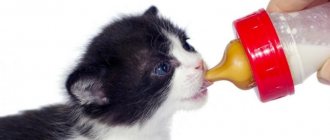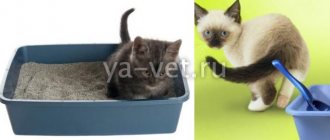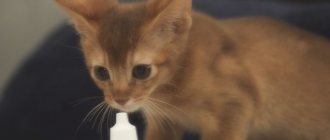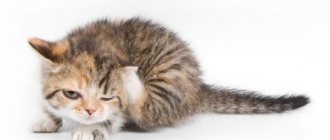If a one-month-old kitten does not poop for several days, the owner should be concerned about the baby’s condition, because long periods between bowel movements negatively affect the pet’s health and cause constipation. Therefore, if an animal is unable to go to the toilet for a long time, and is bothered by accompanying pathological symptoms, it is better not to delay a visit to the veterinarian.
Why a kitten can't poop: reasons
If a newborn cat under the age of one month does not go to poop for two or three days, but his appetite and health are good, there should be no cause for concern. The unformed digestive system is just getting used to the stress, and the intestines are testing their capacity. But when the baby is already eating complementary foods, but rarely visits the litter box - once every four or more days, the owner should pay attention to the pet’s behavior, because often such long breaks are a symptom of an internal disease.
The pathological reasons why small kittens cannot poop on time are:
- Constipation. Often bothers at the age of 2-3 months due to incorrectly introduced complementary foods. A one-week-old kitten may suffer from constipation due to congenital anomalies in the development of the gastrointestinal tract. If the second day ends and the baby does not go to the tray, you should feel his stomach. Elasticity and pain when pressed are a reason to visit a doctor.
- Gastrointestinal dysfunction. It mainly develops against the background of poor quality or unhealthy nutrition. It is also a symptom of a disease of a viral infectious nature.
- Worm infestation. A common reason why a kitten has not pooped for 3 days or more. When parasites are actively multiplying, the animal still eats little or, conversely, has an increased appetite, but the baby does not gain weight well.
- Stress. When a cat is separated from its mother, it reaches its second or third month. Parting with a mother cat is a strong stress, against the background of which the baby cannot go to the litter box on time. It is important to help the kitten quickly adapt to its new home, then the functioning of the intestines will soon return to normal without special treatment.
Reasons for the absence of stool in an adult cat
There are even more reasons for toilet problems in an adult cat. The most common :
- An unbalanced diet that is low in fiber and protein. An abundance of too solid foods (for example, bones) or a lack of fluid can also trigger the problem. Do not overfeed your animal with chicken meat. It can cause constipation.
- Accumulation of hair in the stomach and intestines. An extremely common reason why cats rarely go to the toilet at all. It is especially relevant for long-haired breeds. Hard lumps of fluff in the cat’s internal organs interfere not only with the passage of feces, but also with their formation. This is a serious problem that can even be life threatening.
- Old age, when gastrointestinal motility is slow. The intestines are not able to expel feces normally, and the cat stops going to the toilet normally.
- Sedentary lifestyle. Often characteristic of sterilized cats. It causes not only toilet problems, but also obesity and other health problems.
- The period of sexual arousal in males and estrus in females. When an animal wants to “walk”, all its “thoughts” are only about this. The cat has no time to sleep or eat at this time. Thus, he simply has nothing to poop with.
- Previous operations with anesthesia. After anesthesia, the cat may not go to the toilet for several days. This is explained by the stress that the animal’s body has endured. It takes time for your pet to recover. As soon as all processes are restored, the toilet will also return to normal.
- Using a catheter. Sometimes, before surgery, it is used to clean the animal's intestines. It is quite natural that after catheterization the cat does not go to the toilet longer than usual. It’s just that feces have not yet had time to accumulate in the intestines, which have been emptied to the point of sterility.
- Stress due to moving, guests coming to the house and other events. Cats are big conservatives, and they perceive any changes very painfully.
- Postpartum period in females. The absence of stool during it is explained by the fact that, in preparation for childbirth, the cat went to the toilet more often than usual, and she still has nothing to poop with. Usually, stool returns to normal a few days after the addition to the family.
- Diseases of the gastrointestinal tract. Unfortunately, this is also a possible reason. These may be pathologies such as intestinal obstruction, malignant or benign tumors, adhesions, ulcers, gastritis, etc.
It is not always possible to determine the cause of toilet problems on your own. If there is even the slightest suspicion of health problems, you need to show the animal to a veterinarian. Without professional diagnostics, it will not be possible to identify the disease and cure your pet.
© shutterstock
Symptoms that require you to visit a doctor
The combination of absence of bowel movements and meowing in a baby is a good reason to take him to the veterinary clinic.
If a cat does not pee or poop for more than 2 days, this is a dangerous sign indicating the progression of some internal disease. In addition to problems with bowel movements and urination, other pathological symptoms are often present:
- bloating;
- pain on palpation;
- decreased appetite;
- temperature increase;
- rapid weight loss;
- lethargy, drowsiness;
- incessant meowing.
A newborn kitten aged 1-2 weeks should go to the toilet 3-6 times a day. But 6-8 week old kittens who have tried complementary feeding should visit the litter box once a day every day.
What to do
- Position your kitten for stimulation by holding him in your non-dominant hand under his belly with his rear or butt facing you.
- Wrap a warm, damp washcloth over your dominant hand and stimulate the kitten's abdomen and anal area. You can also use soaked cotton pads or gauze.
- Using your hand and fingers, gently massage the kitten's anal area through the cloth or napkin.
- Check to see if the kitten has pooped, and if not, continue massaging the anal area until the kitten poops.
- Adjust the warm cloth or napkin to ensure the food doesn't stain your kitten, and if you use a napkin, cotton wool or gauze, be sure to dispose of it properly.
- Be sure to clean and dry your kitten as soon as you see that he has stopped pooping.
- Return the kitten to its cage or box and wash your hands thoroughly.
Also, make sure the litter box is cleaned and disinfected regularly because kittens can be very picky about smells. Also ensure that your kitten's litter box is located in a quiet area of your home, away from noise and activity.
Diagnostics
A preliminary diagnosis of a furry can be made based on the results of a physical examination.
If your kitten has not pooped for 2 days or more, and it seems that he cannot do it on his own, you should take your pet to a veterinarian, who will help determine the cause of this condition. The doctor will examine the cat, ask the owner what symptoms are bothering the animal, and collect other important data. To determine an accurate diagnosis, referral is given to a number of additional diagnostic procedures:
- general blood and urine analysis;
- microbiological examination of stool;
- biochemistry;
- Ultrasound of the abdominal organs.
How to help a cat yourself
Fortunately, much more often a cat does not go to the litter box for a long time for reasons not related to illness. What to do in this case? How to help an animal? It all depends on the situation. Sometimes you just have to wait. For example, if the cat “forgot” about the litter box due to severe stress. As soon as the frightened animal “crawls out from under the sofa” and comes to its senses, the “toilet” problem will be solved by itself.
The same applies to the postpartum period in cats. Here you can try to speed up recovery by offering your pet liquid meals. If the reason for the long absence of bowel movements is sexual arousal, you can also just wait it out, or you can help the animal by giving him libido-reducing pills or finding a “mate.” The last option will work, but not for long. The best solution and guarantee of getting rid of pain is sterilization.
If there is a suspicion of hair accumulation in the gastrointestinal tract, cats are given a little Vaseline oil. Of course, the animal is unlikely to eat it of its own free will. However, you need to try to pour a small amount of the product into its mouth, holding it with your hands so that the pet swallows the oil. Literally a day later, the pet will feel the urge to defecate and visit the litter box.
If a cat does not go to the toilet for 5 days, and no serious health problems have been identified, then constipation is a situational phenomenon. It can cause serious damage to the body, so you should not pull it. It is allowed to give the cat a laxative such as Duphalac or do a cleansing enema.
© shutterstock
It is advisable to consult a doctor regarding both the first and the second. Most often, the cause of constipation is errors in the diet. What and how to feed your cat so that it goes to the toilet normally is described below.
What treatment is prescribed?
If a Sphynx, British, Scottish or other breed has problems with bowel movements, the first thing you need to do is review the diet. It is possible that the cat eats low-quality food, which is the reason for the problems that disrupt digestion. When feeding dry food, it is important to ensure that the animal always has clean, fresh water freely available.
Vaseline oil will make it easier for your fluffy to defecate if he takes it several times a day.
If a kitten wants to go to the toilet, but cannot, it is recommended to periodically give it a microenema. The liquid for the procedure, be it saline solution or ordinary boiled water, should be slightly cooler than room temperature. This will help activate intestinal motility, so that stool will quickly leave it. Another way to get a kitten to go to the litter box is to take Vaseline oil. It is recommended to give the product to the baby 2-3 times a day, 1.5 ml per kilogram. This oil is useful for constipation because it is not digested in the stomach and is not absorbed by the intestines, due to which the walls are enveloped in the substance. The feces immediately soften and the cat can poop without any problems. It is important to remember that you cannot replace Vaseline oil with vegetable oil - sunflower, olive or castor oil, since they are absorbed in the colon and do not have any effect.
If such methods do not cope with the problem, and the kitten does not poop for many days, there is nothing left to do but start taking medications. The drug is prescribed only by a veterinarian after determining an accurate diagnosis. Lactose-based medications are used. The following are considered effective:
- "Duphalac";
- "Lactusan";
- "Lizalak."
How to tell if a kitten is constipated
The animal becomes restless, runs around, looks for a place to go to the toilet, meows loudly when it sits in the tray for a long time. When palpating the abdomen, he tries to escape, since such movements cause pain for him.
When feeling the stomach, you can feel an oblong lump along the body, mainly on the right side, or a foreign object.
In a kitten, prolonged absence of stool can cause vomiting, lethargy, fever, and intermittent breathing.
What to do for prevention?
If the baby has not yet gotten used to the new owners, then their task is to accustom him to the new toilet.
As soon as the kitten appears in the house, you must immediately introduce him to his personal toilet and show him where the litter box is located. Sometimes in a new place an animal does not know where to relieve itself, and its upbringing does not allow it to go anywhere. In this case, the baby suffers, which is why constipation appears. Another important point is the selection of proper, balanced nutrition. It is better to create a diet or select a suitable brand of ready-made food together with a veterinarian.
It is forbidden to suddenly switch to a new type of food, and if the cat eats natural food, it is important to ensure that prohibited foods do not fall into his bowl - fried, spicy, salty, fatty, sweets. In addition, you should periodically give your pet anthelmintic drugs, and promptly treat the animal for fleas, lice and ticks. If there are characteristic symptoms of digestive disorders, do not self-medicate, but take your four-legged friend to an appointment with a veterinarian.
What to feed a cat with constipation
If constipation occurs, you need to reconsider the animal's diet. Food should be light with plenty of water or low-fat broth based on chicken meat (skinless fillet) or vegetables (various types of cabbage).
Be sure to read:
Vomiting in a cat: causes, what different types of vomit indicate, first aid, treatment, when it is not dangerous
The kitten's diet includes:
- fermented milk products (kefir, yogurt);
- boiled vegetables (pumpkin, carrots, beets, zucchini)
- fiber-rich cereals (oatmeal, pearl barley, millet).
The main thing is that the diet needs to be balanced with the gradual introduction of different foods for the kitten.
Do not neglect preventive measures or feed only dry food.
“Worms”: how to identify uninvited guests
In modern conditions, helminthic infestations seem to many to be something casuistic, and therefore do not cause concern. In fact, “worms” still occupy a prominent place in the structure of persistent deficiency conditions (especially often iron), pathologies of the liver, skin, and bronchopulmonary system. And identifying them requires understanding a number of features.
"Whelminthic" symptoms
It is worth noting that parasites do not benefit from the death of the host. Therefore, their presence, as a rule, is not accompanied by any signs for a long time.
1. Loss of appetite and unmotivated weight loss may come to the fore.
2. Also characteristic are recurrent deficiency conditions, the “nutritional” or any other origin of which has already been excluded. And most often, “carriers of worms” suffer from iron deficiency anemia.
3. In addition, parasites irritate the immune system, due to which they can provoke the development of allergic (including bronchial asthma) and atopic diseases.
4. If worms and larvae “choose” the intestines to inhabit, among the first signs of invasion there may be dyspeptic symptoms such as nausea, stool disorders, flatulence, periodic abdominal pain, as well as intolerance to certain foods.
5. And when the liver comes under attack, most often the “finding” is accidental, in the form of an “unexplained” increase in markers of liver inflammation (ALT, AST) or changes on ultrasound.
Therefore, first of all, the examination is indicated for those who already have similar pathologies of unknown origin, or a high risk of infection (for example, trichinosis from eating undercooked meat of pigs and wild boars or lard with layers of meat).
When “feces” is not informative
The most famous study is undoubtedly the “feces on worm eggs.” However, this analysis has a number of objective disadvantages, due to which it is not capable of providing high detection of parasites.
Firstly, feces can help in identifying only those helminths that have “stopped” at the intestinal level. While the larvae are able to migrate to a number of other organs, including the liver, muscles, lungs and even the brain.
Secondly, the analysis is designed to detect only worm eggs, that is, it is highly dependent on the life cycle of the parasite.
“Guessing” at what point in time the worms will “decide” to lay eggs is obviously an impossible task. After all, there are no visual signs of this stage of their “life”.
Therefore, it is recommended to test feces for helminths several times (at least 3) with intervals of several days. And even in this case, the “chances” of identifying parasites remain quite low.
A blood test for antibodies to helminths does not have such disadvantages, and the sensitivity of the study to different types of worms reaches a high 75-90%.
In this case, IgG antibodies appear in the blood 3-4 weeks after infection. The analysis can be carried out either specifically to the type of parasites of interest, or comprehensively, taking into account the most common parasitoses.
The detection of antibodies to parasites in the blood is a justified reason for the use of drugs and an in-depth examination of the target organ, even if nothing bothers the patient.
And, among other things, such an analysis successfully complements traditional diagnostics based on stool analysis.
Causes of intestinal colic in children
The main reasons leading to the development of colic in children include:
- Unformed nervous regulation of the baby’s intestines.
- Increased gas formation due to a lack of enzymes in the gastrointestinal tract.
- Intestinal dysbiosis, that is, a violation of the intestinal microbiota. To put it in more accessible language, this means an imbalance between the microorganisms that inhabit our intestines.
- Poor nutrition for nursing mothers.
- Gallbladder dysfunction.
- One of the most studied causes of intestinal colic is currently intolerance to cow's milk proteins.
As stated earlier, the main cause of functional diseases is a violation of the nervous or humoral regulation of the functioning of internal organs. In this case, there is a violation of the regulation of intestinal activity in a newborn and infant.
Selecting a location
How to train a kitten to use a litter tray? If you are just planning to take a baby, then you need to immediately approach the responsible task correctly. The first purchase for a kitten, of course, is a tray, which it is advisable to choose correctly.
Let's look at some types:
- The cheapest option is a plastic tray with low sides. It washes well and takes up little space, but a significant drawback is that it is used together with filler granules, which the kitten can scatter or eat (you need to think about eating in advance).
- Tray with mesh. Can be used without filler. It has high sides. Cats like these because they look like boxes.
- Tray in the form of a house (closed type). The advantage of such a device is its aesthetics, the disadvantage is the high cost of the device.
- Self-cleaning tray. This option has a number of positive qualities: the cleanliness of the tray does not require the owner’s attention; no odor; Four pets can go into this tray; presence of a motion sensor; safety of capsules. The negative aspects are: connection to water supply and electricity, noisy flushing, which can frighten the animal.
Prevention measures
Such an unpleasant phenomenon as constipation can be completely avoided. To do this, you need to adhere to the simplest rules of prevention:
- Give your kitten antiparasitic medications regularly to prevent the accumulation of helminths in the intestines.
- Teach your baby to an active lifestyle. An active, playful kitten suffers from constipation much less often than a phlegmatic little ball that constantly sleeps.
- If constipation is accompanied by vomiting, consult a doctor immediately!
- Brush the fur regularly to prevent it from collecting in the intestines.
- Adjust the menu. It must contain the required amount of fat, liquid, and fiber.
And lastly: do not neglect regular examinations by the veterinarian, because constipation may be caused by some quietly developing pathology in the baby’s body.











